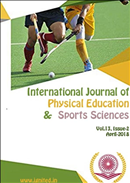Spinal Deformities & School Bags: Role of school bags in developing spinal Deformities in Northern India Implications for Spinal Health and Rehabilitation Programs
Main Article Content
Authors
Abstract
The primary objective of study was to find out the status of spinal deformities among the school children of northern region. The secondary objective of study was to find the impact of school bags on the spinal health of school children in Northern India. The data was collected from two major states namely Punjab and Uttrakhand of Northern India. The total sample size was 1000 school children (525 male 475 females) in the age range of 10-15 years. The selected spinal deformities were kyphosis and lordosis. The selected deformities were measured by measuring the angles of thoracic curve and lumber curve with the help of a flexicurve ruler. Anyone who was having 45 or more than 45 degree was kept into the category of spinal deformity. The heaviness of school bag was assessed with the help of a questionnaire asking whether the student finds hisher bag heavy and if yes then how does she carries it. The data was analyzed by employing descriptive statistics and chi square test. The level of significance was set at .05. the results of the study revealed 87 percent of the children in northern India are suffering from either of the deformity. The study further revealed that kyphosis was more prevalent in comparison to lordosis deformity. It was also found that 37 percent of the children were having both deformities i.e. Kypho-lordosis. the results of the study further revealed a significant association of heaviness of school bag with the spinal deformity as whole and with occurrences of lordosis. Status of kyphosis was found insignificant with the heaviness of school bag. It has been further revealed that gender has no role play in the incidences of spinal deformities among the school children in Northern India. The results of study have showed significant results at same time it is giving an alarming information for the need of rehabilitative classes.
Downloads
Download data is not yet available.
Article Details
Section
Articles

